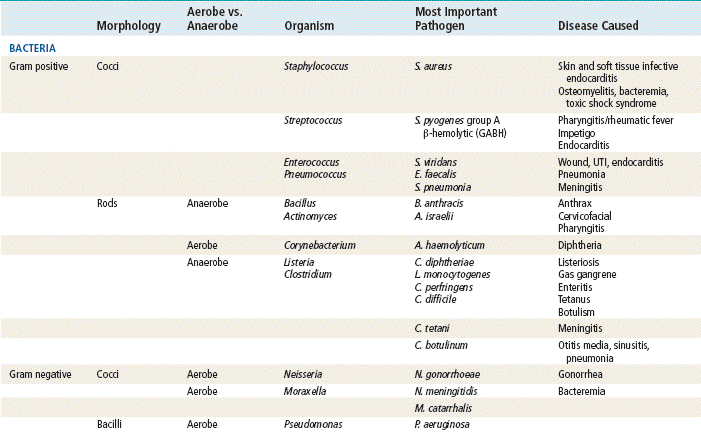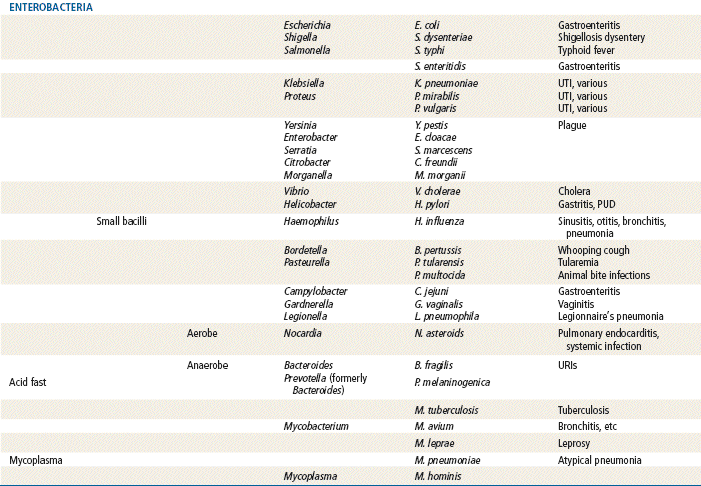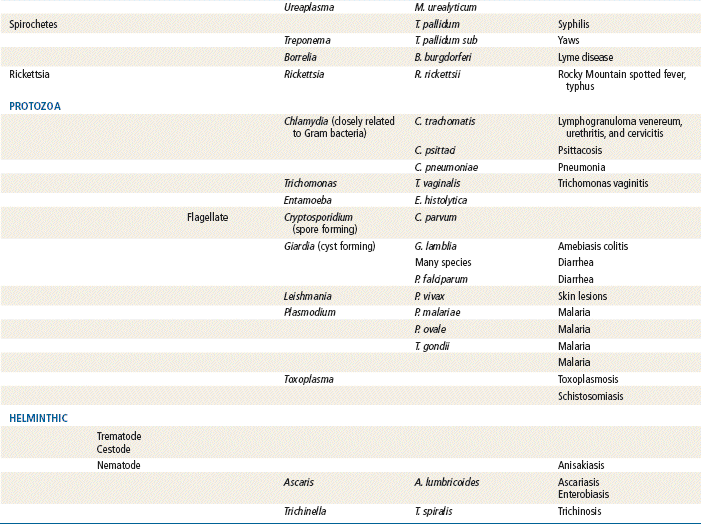http://evolve.elsevier.com/Edmunds/NP/
This chapter discusses general treatment principles applicable to most infections, with an emphasis on those of bacterial origin. Although these general guidelines cover the most common first-line primary care drugs, many exceptions are made to these recommendations. Remember to consider each patient with an infection as an individual case. Patterns of resistance change constantly and guidelines for treatment are updated at least yearly. Although these recommendations were the most current on publication, do not fail to consult the newest information from state and federal sources. The emphasis in this unit is on typical oral treatment for common primary care problems. The only exception is the use of single IM injections primarily for the treatment of sexually transmitted diseases. The first nine antiinfective chapters are focused on bacteria. Viruses and protozoa are discussed in Chapter 69; fungi are discussed in Chapter 67.
Therapeutic Overview
The taxonomy of bacteria is undergoing changes that reflect the new body of information about the genetic components of bacteria. See Table 57-1 for information on bacteria that are important pathogens. Bacteria are one-cell organisms with a primitive nucleus and rigid cell walls that are porous and permeable to substances of low molecular weight. Gram-negative bacteria have a more complex cell wall than gram-positive bacteria. Bacteria are called gram negative or positive according to the results of laboratory Gram stains. The difference in their cell walls is an important factor in the ability of an antibiotic to penetrate the cell walls of bacteria and kill the bacteria. Another variable that is important in decision making is whether bacteria are aerobic or anaerobic (i.e., whether or not they need oxygen). This trait will determine where in the body the organism will grow best and potentially cause infection. This information is important when one is selecting appropriate antimicrobial therapy in the absence of culture results.
Bacteria (including rickettsia and spirochetes), protozoa (e.g., chlamydia, others), fungi, viruses, and retroviruses cause infection. A rickettsia such as Borrelia burgdorferi (Lyme disease) is a small gram-negative obligate intracellular bacterium. Spirochetes such as Treponema pallidum (syphilis) are highly coiled bacteria.
Pathophysiology
Infections are among the most common reasons for primary care visits. Respiratory tract infections include acute URIs, bronchitis, pneumonia, chronic sinusitis, acute pharyngitis, and otitis media. Other infections commonly seen in primary care are UTIs, eye infections such as conjunctivitis, ear infections such as otitis media and externa, and skin infections such as cellulitis, impetigo, and acne. See Chapter 58 for details.
More than 150 million prescriptions for oral antiinfectives are written each year in the United States. However, this number decreased, especially in children, from 1992 to 2000, because of the emergence of antimicrobial resistance and more appropriate prescribing efforts. Nevertheless, among all types of health care providers, antiinfectives rank as one of the most frequently prescribed products. Although their efficacy in decreasing mortality and morbidity is unquestioned, the overuse and abuse of these products have led to drug resistance and have raised the specter of a return to the time when clinicians were powerless to cure patients with virulent infection.
To summarize the most important general information clinicians need to know when using different types of antiinfectives, a brief review of relevant information is provided here rather than with each antibiotic chapter. Mastery of this foundational material will facilitate accurate decision making. More difficult or detailed clinical problems may require the clinician to review additional anatomic, physiologic, or microbiologic texts before making treatment decisions.
Accurate identification of the offending organism is the most critical clinical decision that must be made with any infection. This often is possible to do through simple laboratory tests, such as Gram stains, which many clinicians are able to perform in their offices. Some organisms require more extensive testing in commercial laboratories, and results may not be available fast enough to be helpful for initial treatment decisions. Knowledge of which organisms are endemic in the community during that season and which organisms seem to have developed resistance to different drugs is also important for the clinician.
Assessment
Take a thorough history, especially regarding allergies, other drugs the patient is taking, and previous antibiotic treatment. If the patient has had a previous allergic reaction, determine the type of reaction. If the infection is in the respiratory tract, inquire about smoking. Look for concomitant illness and other complicating factors. Ask about travel, work history, and exposure to high-risk environments (e.g., college and military dormitories, child care centers, patient care facilities, ill family members).
Best practice is to confirm the diagnosis of bacterial infection before placing a patient on an antibiotic. Viral infections should not be treated with an antibiotic.
At least 90% of URIs are viral. When treating infection, assess whether any symptoms or signs indicate a bacterial infection. If not, consider culturing and waiting to treat until the culture results are available. If the patient has signs and symptoms that indicate probable bacterial infection, consider empirical treatment until culture results are available. Signs and symptoms that indicate bacterial infection are not always obvious and clear cut. Generally, they may include fever higher than 102°F, lymphadenopathy, swelling, and pain. Organ-specific signs and symptoms may indicate a bacterial infection of particular tissue. No formula can be given that says that if x, y, and z are present, the patient always has a bacterial infection. The clinician must have a high index of suspicion, order appropriate testing, and recognize when a patient is really ill through a blended knowledge of art and science.
Some of the red flags that suggest that serious bacterial infection may be present include the following:
Although minor infections account for most visits to primary care practices, always consider referral to a specialist for unusual symptoms or unusual responses to treatment. Infectious disease and pulmonary specialists are highly attuned to knowledge of community-acquired infections and their treatment, as well as to the more exotic presentations. Simple localized infection may progress to septic shock within hours, and the clinician must not discount the ominous symptoms of shaking chills and soaring temperatures or decreased temperature with changes in mental status that require emergency attention.
Studies show that outpatient antibiotic use, while decreasing, is still too prevalent. Currently, providers are increasingly using newer and broader-spectrum agents without rationale. Overuse of antiinfectives and resulting drug resistance not only affect the individual patient but also lead to the development of resistant strains of bacteria that then are spread throughout the community and globally. Resistant bacteria cause infections that are harder to treat, last longer, and require hospitalization with resulting increased health care costs. Future infections may also prove resistant to antiinfectives. As a result, the patient experiences more frequent infections with a narrowing range of therapeutic options. For example, otitis and sinusitis are conditions for which resistant strains have become a major problem. Administering antiinfectives for viral infection prophylaxis when not needed also places the patient at increased risk for adverse effects (including allergy, anaphylaxis, and death). Because of recent programs undertaken to educate primary care providers and patients about the dangers of overuse of antiinfectives, the inappropriate prescription of antiinfectives for viral infections has decreased for many groups in the past few years. Research documents that elderly patients still seem to have a high rate of inappropriate prescription of antiinfectives.
Despite pressure from the patient for quick relief, it is good practice to culture first and treat second for any significant type of infection. Many well-educated patients will be accepting of a “wait and see” approach. Culturing first provides results that direct definitive therapy with an antibiotic to which the organism is susceptible. If the patient is acutely ill, treat empirically until the results of the culture are available. Be sure to check the culture results to see whether the organism is susceptible to the drug prescribed. If the site cannot be cultured, treat empirically and cover the likely pathogens. If treating empirically, be sure to check with the patient in 2 to 3 days to see if he or she is improving. Determine the most likely pathogen by assessing the location of the infection and the patient setting such as community, nursing care facility, or recent hospitalization.
Gram Positive vs. Gram Negative
Identification of an organism as gram positive or gram negative helps the clinician move to the next critical decision for choosing an antibiotic that will be effective against the specific organism.
The Gram stain is a laboratory test that is used to divide bacteria into two groups, reflecting basic differences in cell wall composition. Gram-positive bacteria retain the staining dye and appear deep violet on the microscopic slide. Gram-negative bacteria do not retain the dye and appear red on the slide. Gram-positive cell walls are low in lipids, whereas gram-negative cell walls are high in lipids. Many but not all antiinfectives exert their effects via action on cell walls, so cell wall differences determine whether certain antiinfectives will be effective.
Anaerobes are organisms that can grow in the absence of oxygen. This characteristic allows them to grow in necrotic tissue and poorly aerated portions of the respiratory tract. Mycobacteria such as the TB organism do not Gram stain; they have very tough cell walls and are difficult to kill. Yeasts are gram positive; rickettsiae are gram negative.
Stay updated, free articles. Join our Telegram channel

Full access? Get Clinical Tree





